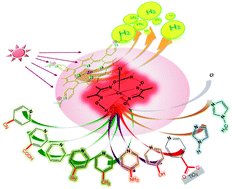Photochemical hydrogen production and cobaloximes: the influence of the cobalt axial N-ligand on the system stability†
Abstract
We report on the first systematic study of cobaloxime-based hydrogen photoproduction in mixed pH 7 aqueous/acetonitrile solutions and demonstrate that H2 evolution can be tuned through electronic modifications of the axial cobalt ligand or through introduction of TiO2 nanoparticles. The photocatalytic systems consist of various cobaloxime catalysts [Co(dmgH)2(L)Cl] (L = nitrogen-based axial ligands) and a water soluble porphyrin photosensitizer. They were assayed in the presence of triethanolamine as a sacrificial electron donor. Optimal turnover numbers related to the photosensitizer are obtained with electron-rich axial ligands such as imidazole derivatives (1131 TONs with N-methyl imidazole). Lower stabilities are observed with various pyridine axial ligands (443 TONs for para-methylpyridine), especially for those containing electron-acceptor substituents. Interestingly, when L is para-carboxylatopyridine the activity of the system is increased from 40 to 223 TONs in the presence of TiO2 nanoparticles.


 Please wait while we load your content...
Please wait while we load your content...